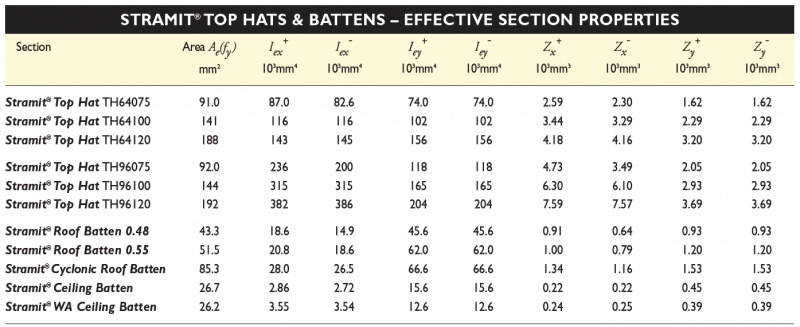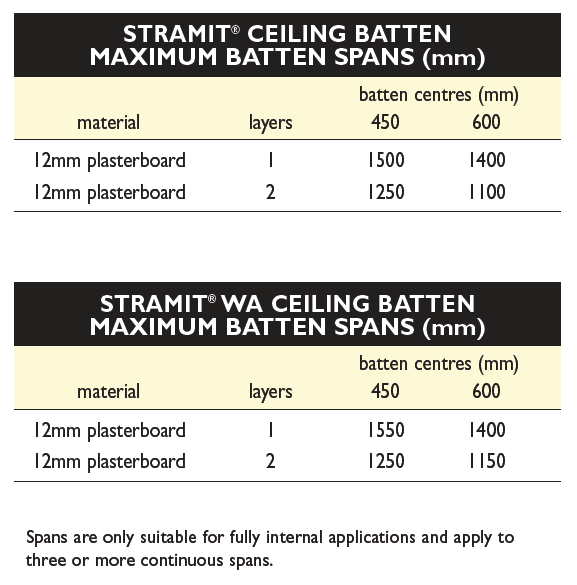- Durable, rot free and fire resistant
- Knurled anti-slip surfaces on roof and ceiling battens for quick and easy installation
- Rolled safety edges on roof and ceiling battens
- Easy to handle and store
Stramit Roof and Ceiling Battens are manufactured from high-tensile (G550/G500) steel with either AZ150 zinc-aluminium alloy or Z350 galvanised coating conforming to AS1397.
Contact us to discuss other coatings, grades and materials options.
Where to Buy
Stramit account holders can buy Stramit® Roof and Ceiling Battens from their local Stramit office. We do not sell direct to the public but our products are stocked by retail outlets across Australia.
Availability
This product is available Australia-wide. Lead times may vary depending on location.
News and Case Studies
Check out Stramit’s latest news, product releases and updates, and case studies featuring our quality Aussie-made steel products.
General Information
Stramit® Roof and Ceiling Battens will give excellent durability in most applications. In exposed conditions, unwashed areas subject to salt-laden air or other corrosive matter may need additional protection. Stramit® Roof and Ceiling Battens are not recommended for use in enclosed areas within 450mm of moist soil.
Stramit recommends that all design conform to relevant Australian Standards such as AS1170 series (Loading Codes), AS4600 (Cold-formed steel structures) and AS3623 (Domestic metal framing).
All building products need to be checked for compatibility with adjacent materials, whether they be part of the current project or pre-existing or planned building elements.
Avoid placing on or in conjunction with components made from copper, lead, green or treated timber, stainless steel and mortar or concrete.
Contact your local Stramit office for more detailed information.
Stramit structural products should be handled with care.
Packs should always be kept dry and stored above ground level while on site. If the sections have become wet, they should be separated, wiped and placed in the open to promote drying.
Stramit® Roof and Ceiling Battens are available in stock lengths or cut to length (minimum and maximum lengths may apply). Contact your local Stramit Office or refer to the Stramit Product and Service Guide for your area for further detail.
Stramit's structural products are protected in Australia by registered designs.
Contact our technical services consultants if you require further information or advice for your local conditions and practices.
Technical Information
All roof battens/ceiling battens shall be Stramit sections or approved equivalent supported by submission of section properties and capacity calculations/data in accordance with AS4600, AS3623 and AS1562.
All sections shall be produced from high-tensile G500/G550 steel with a galvanised/zinc-aluminium alloy coating conforming to AS1397.
All sections must be installed in accordance with the manufacturer's recommendations with particular reference to the number, size, grade and positioning of fasteners.
Limit-state design capacity tables for Stramit Roof Battens for use in non-cyclonic areas are located in the Stramit Top Hat Sections Product Technical Manual.
Contact your local Stramit office for information on use of the products in cyclonic areas.
Information on the use of the Stramit Cyclonic Roof Batten in the Darwin area can be found in the deemed to comply sheets in the Darwin Area Manual. These sheets can also be obtained from your local Stramit office.
Each application must conform to the specific details outlined in the Design Data Sheets.
The following fasteners are recommended for fixing Stramit® Roof and Ceiling Battens:

Stramit can also supply cold formed steel sections that can be used for stud, plant and nogging frames. These conventional sections are easily assembled using conventional techniques.
All loadings used in deriving the design data are assumed to either act uniformly along the top central flange of the sections or, for connections to support members, evenly between each of the lower flanges (feet).
Foot traffic loadings, where used, are based on AS1562.
Stramit® Roof and Ceiling Battens are manufactured from high-tensile (G550/G500) steel with either AZ150 zinc-aluminium alloy or Z350 galvanised coating in full conformance with AS1397.
Stramit® Roof Battens may be used with either metal sheeting or with concrete/terracotta tiles. The relevant performance can be obtained from the relevant Technical Manuals.
Stramit® Fascia Battens provide protection to installed Stramit® Fascia during the roof installation.
Stramit® Roof and Ceiling Battens are available in a range of sizes, selected to match the dimensions of adjacent structural members. Additionally all Stramit® Top Hats are available in various thicknesses to allow designers flexibility between performance and economy. Size and mass details are below:

Roof batten spacings are influenced by support (truss) spacing, sheeting capacity or roof tile spacing.
Ceiling batten spacing is selected to suit plasterboard manufacturer’s requirements.

Based on the foot traffic requirements of AS3623, the maximum span for Stramit 0.48 Roof Batten is 900mm and Stramit 0.55 Roof Batten is 1200mm. This assumes a maximum batten spacing of 300mm and a maximum tile weight of 0.67 kPa.
Installation Information
Should cutting be required, use a power saw with a steel cutting blade or a power nibbler. Avoid the use of abrasive discs as these can cause burred edges. Please dispose of any off-cuts carefully.
Always use the correct size and quantity of fasteners as specified by the design engineer. Pairs of screws at connections must be directly in line (parallel with the supporting member).

Consideration should be given to handling and installation issues as part of site induction safety procedures. Specific consideration should be given to pack handling, and avoidance of cuts, trips, slips and falls, long section handling, particularly in windy conditions, and surface temperature on sunny days.
Wear safety glasses with side shields when cutting or trimming product. Cut resistant or leather gloves should be worn when handling product. Foot protection should be warn when handling and transporting product.
Stramit recommends that good trade practice be followed when using these products, as outlined in AISC/Australian Standards HB62 part 1 and HB39.
Stramit® Roof and Ceiling Battens have a lightly knurled upper surface that assists in maintaining a foothold.
Stramit® Roof Battens are designed to withstand foot traffic load during installation and service. Stramit® Ceiling Battens are not able to sustain foot traffic loads and must therefore not be walked on.
Stramit does not recommend the welding of roof and ceiling battens. The heat produced in welding will affect the material properties of the high-tensile cold-formed steel used by Stramit in all its sections.
In many instances considerable stress concentrations are likely to arise, even with good quality welding. In addition, welding will locally remove the galvanized coating leading to a potential reduction in durability.

